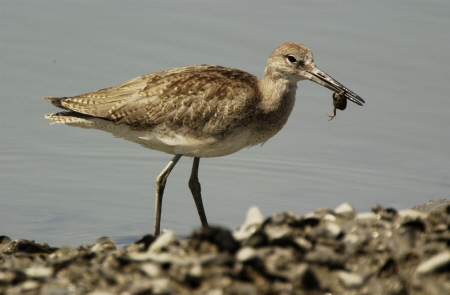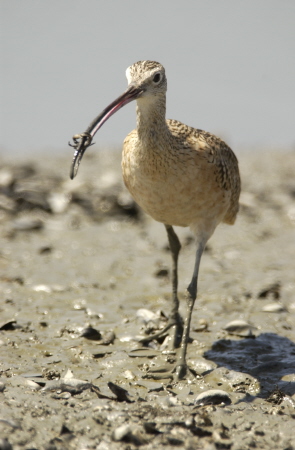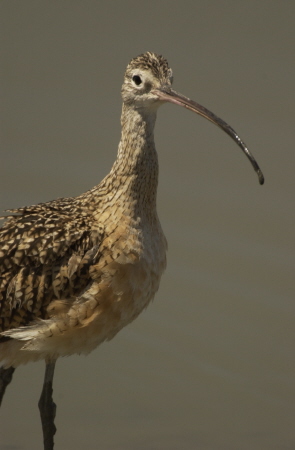Built for Speed! --August 10, 2001
| With my D1X back at Nikon for service today was the perfect day for my D1H to
arrive. And since it arrived long after the early morning light was gone, today
was also a day to give it a really tough test by taking it out to shoot birds at
mid-day.
Just as with the D1X the first impression on opening the box is a little disappointment that not more has changed. The same packaging, the same accessories, and a nearly identical camera body except for that telltale D1H and the same new button placement as on the D1X. But, just as with the D1X, a lot has changed under the hood. |
|
Before even starting to fire the camera, I highly recommend setting up a couple of the custom settings so you don't forget in your excitement. You certainly want to change the image quality setting--either to Fine for normal JPEG captures, or to one of the Raw modes if you like to do your own fiddling with the bits. And you probably want to change the Color Mode (CSM-32) to II (Adobe RGB) to get richest and most accurate color in your images.
Then it's pretty much mandatory to fire off a 40-frame burst. Something that hasn't been possible before now except for those who still bulk load their own film. To cut to the chase on camera speed--as Moose has already reported--it is incredibly fast! In several hours of shooting flight shots and shorebirds I never once had it lock-up waiting to write frames. In a bench test, using manual exposure, manual focus, and 12x 256MB Lexar CompactFlash cards the D1H wrote frames to the card at almost exactly twice the speed of the D1. The D1 can at best write 21-22 frames in about 30 seconds while the D1H can write over 40 in the same time. Keep in mind these were "lens cap on" test frames and the camera was in a very unlikely mode, so the test is just for comparison purposes. While they were bursting both cameras approached 6fps, so there didn't seem to be much difference there.
Continuing with the theme of speed, the D1H has the same "instant review" Rear LCD that the D1X has. This alone saves quite a bit of time and helps get you ready for the next shot much more quickly. By being able to review your shots and flip between them at the speed of your thumb you can do more review in the field and improve your image quality. Unfortunately this also points out a firmware bug in both the D1X and D1H that doesn't seem to be fixed yet. CSM-27, which is supposed to set the Highlights and/or Histogram to display on review, doesn't seem to have any effect. You can scroll "left" to get either screen but not both at once. Image review is also turned on or off for both S and C modes at the same time using CSM-1 (on the D1 it was only turned on with Single shot mode). This is mostly good, as you get to review very quickly all the time, but leaving review on caused me to use batteries quite quickly. (And yes, these were seasoned batteries from my other cameras, not the new one that came with the D1H)
All in all the D1H is a real treat to shoot with. It is the most responsive digital camera ever made and the most suited to action photography.
But what about the images?
Well, since they are the same resolution as the D1, there isn't any huge hype surrounding the D1H images. But Nikon has definitely made life easier than with the D1. First, the flash exposure issues are largely fixed, just like with the D1X. That may not be a life or death issue, but it sure makes life easier and faster than constantly changing flash modes depending on subject and distance. Second, the new Adobe RGB color space, as with the D1X, saves those of us who shoot JPEGs an entire step in our workflow. No longer do we need to carefully open images through a custom D1 profile or have Photoshop actions to tweak the color. I'm sure there will still be custom profiles and the magenta issue doesn't appear to have completely disappeared, but 90% percent of my shots with the D1H and D1X have come out of the camera with the color the way I wanted them. That saves quite a bit of time. However, it also assumes that you've gotten the white balance set correctly for the conditions and your intent. The D1H and D1X don't really improve Nikon's white balance algorithms, so you still need to be constantly aware of how you have it set and make sure you're getting the color right in the first place.
And the metering?One of my complaints about the D1 is that it often doesn't meter subjects correctly in full sunlight--if the background is bright or the subject large it usually does fine, but if the background is dark or the subject small the highlights are often burnt out. So of course I had to try the D1H on birds in the mid-day Sun. The result was a definite improvement. The camera still isn't magical and it's very easy to blow out white subjects unless you use quite a bit of minus compensation, but it was able to retain highlights in medium tone subjects. I've included two images of a Long-billed Curlew here. The first was shot straight (no compensation) and the second one with -2/3. You can see that while the camera holds the image highlights in both there is still a noticeable improvement in the richness of the color on the sunlit side of the bird by using minus compensation. |
|
|
Moose found the D1X didn't meter
correctly in fog and I found some issues with it with light subjects in
overcast conditions, so that'll be an area to watch to see if the D1H has
the same issues in future shoots.The best partPerhaps the best part of the new Nikons for me is the improved "out of the camera" color. The images you see on this page were taken directly from the camera with no image editing performed. I batch resized them using DigitalPro but no other color mapping or tricks had to be played. That's a substantial time savings when doing submissions to editors. So, in short, I'm thrilled with my first day with the D1H. Nikon has solved several of the annoying shortcomings of the D1 as well as sped the camera up considerably. What I don't know yet is whether the D1H or the D1X will become my primary camera. Stay tuned! Tomorrow I'm shooting a car race and will give the D1H a different sort of workout. --David Cardinal |
 Willet, f8 at 1/250, Matrix no comp
Nikon D1H w. Nikon 600mmf/4 and TC-20E II
Photo by David J. Cardinal
Willet, f8 at 1/250, Matrix no comp
Nikon D1H w. Nikon 600mmf/4 and TC-20E II
Photo by David J. Cardinal Long-billed Curlew
Nikon D1H, 600mmf/4, Matrix, no comp
Photo by David Cardinal
Long-billed Curlew
Nikon D1H, 600mmf/4, Matrix, no comp
Photo by David Cardinal Long-billed Curlew at f/6.3
Nikon D1H, 600mmf/4, Matrix, -2/3
Photo by David Cardinal
Long-billed Curlew at f/6.3
Nikon D1H, 600mmf/4, Matrix, -2/3
Photo by David Cardinal
